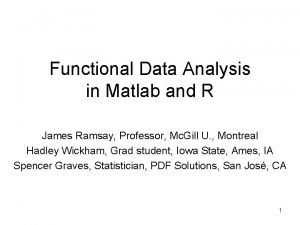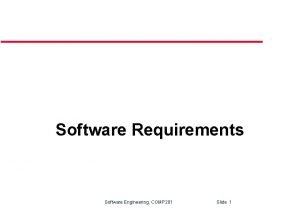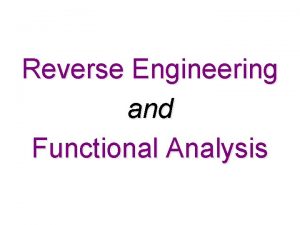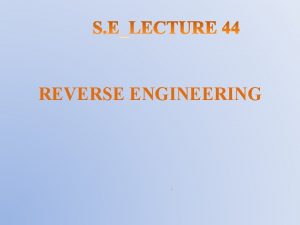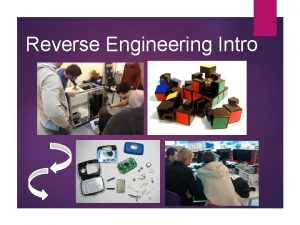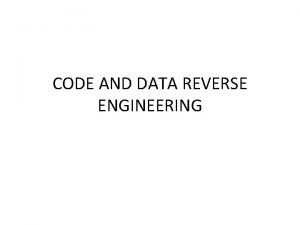Reverse Engineering and Functional Analysis Reverse Engineering Reverse











- Slides: 11

Reverse Engineering and Functional Analysis

Reverse Engineering Reverse engineering (RE) is the process of taking something apart and analyzing its workings in detail, usually with the intention of understanding its function. Engineers use this information to prepare documentation, generate electronic data, or construct a new or improved device or program.

Why Perform RE? • Improve the design of a flawed product. • Improve the design of a part to maximize manufacturing techniques and appropriate materials. • Redesign a part to increase a company’s profit margin. • Discover how a competitor’s product functions.

Why Perform RE? • Create documentation and part files that were non-existent. • Continue the development of a well-designed object. • Reduce negative environmental impacts.

Stages of RE • Visual Analysis • Functional Analysis • Structural Analysis

Functional Analysis After a product has been selected, a nondestructive Functional Analysis is performed. First, the product’s purpose is identified. Next, observations are made to determine how the product functions. These observations are recorded in detail. Lastly, the system’s inputs and outputs are listed.

Functional Analysis Example The purpose of a toothbrush is to clean teeth and gums to prevent tooth and gum decay. Water and a cleansing paste are also used in conjunction with the brush.

Functional Analysis Example The engineer makes an annotated sketch of the product and labels all of the visible components. This information is used to write up a detailed analysis of the object’s sequential operation, or function.

Black Box Systems Model A black box systems model is used to identify what goes into and out of the product in order to make it work as a system. Inputs Product Function Output

Black Box Systems Model The “black box” is used to represent the product’s internal components or processes, which are deemed unknown at this point. Inputs Product Function Output

Functional Analysis Example • Sound • Heat • Waste • Clean teeth and gums • Hand motion • Toothpaste • Water • Energy Inputs Product Function Output
 Functional analysis reverse engineering
Functional analysis reverse engineering Functional analysis reverse engineering
Functional analysis reverse engineering Forward engineering and reverse engineering
Forward engineering and reverse engineering Classification of space maintainer
Classification of space maintainer Functional and non functional plasma enzymes
Functional and non functional plasma enzymes Enzymes of blood plasma
Enzymes of blood plasma Functional and non functional
Functional and non functional Engineering functional analysis example
Engineering functional analysis example Reverse engineering vs forward engineering
Reverse engineering vs forward engineering Reverse calculations functional skills maths
Reverse calculations functional skills maths Functional data analysis with r and matlab
Functional data analysis with r and matlab Software requirement and design
Software requirement and design










